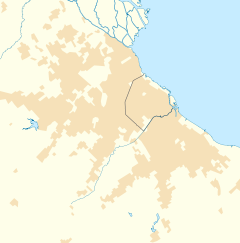Paso del Rey | |
|---|---|
 Mitre Avenue | |
Location in Greater Buenos Aires | |
| Coordinates: 34°39′S 58°45′W / 34.650°S 58.750°W | |
| Country | Argentina |
| Province | Buenos Aires |
| Partido | Moreno |
| Elevation | 12 m (39 ft) |
| Population | |
| • Total | 41,775 |
| CPA Base | B 1742 |
| Area code | 54 0237 |
Paso del Rey is a city located 35.5 km west of Buenos Aires, in Moreno, Buenos Aires Province, Argentina.
Paso del Rey (King's Ford) takes its name from the estancia (ranch) owned by Senator Amancio Jacinto Alcorta: Estancia Paso del Rey.

The surrounding area was well-known since colonial times because there was a ford which provided a useful crossing place to get the west bank of the Reconquista River. In fact, Charles Darwin could have crossed the ford in his journey from Buenos Aires to Luján on 27 September 1833 (the only alternative crossing was a wooden bridge known as Puente de Márquez, 4.5 km north).
According to the 2001 census [INDEC], the population was 41,775.
Paso del Rey is bordered by Moreno City (west), Trujui (north) and Merlo and Reconquista River (south).
History
[edit]
The origin of the city goes back to 1938 when the British-owned railway company Buenos Aires Western Railway Co. opens a railway stop between the railway stations of Moreno and Merlo; it was thanks to the efforts of the textile businessman Amadeo Regules.
External links
[edit]- (in Spanish) Municipal website

Well, that’s interesting to know that Psilotum nudum are known as whisk ferns. Psilotum nudum is the commoner species of the two. While the P. flaccidum is a rare species and is found in the tropical islands. Both the species are usually epiphytic in habit and grow upon tree ferns. These species may also be terrestrial and grow in humus or in the crevices of the rocks.
View the detailed Guide of Psilotum nudum: Detailed Study Of Psilotum Nudum (Whisk Fern), Classification, Anatomy, Reproduction